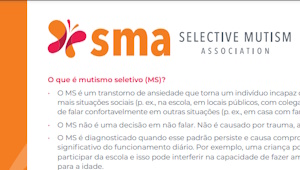Online Library
Letter to Friends and Relatives About Your Child’s Selective Mutism
How to Share Information About Your Child’s SM with Friends and Family
Your friends and relatives are often confused by your child’s selective mutism (SM). They’ve noticed for a long time that your sweet child doesn’t talk to them, or maybe in front of them, or that the child only whispers in your ear in front of them. Sometimes, as painful as it is, your child may not be talking at all to some very close friends or relatives, even though these people are perfectly nice. Some only wish they knew how to help. Some, unfortunately, may be showing your child their frustration and may even be saying some guilt-inducing things from time to time. We encourage you, the parents, to be your child’s best advocate and to proactively talk to friends and relatives about what you want them to do. If you are the parent, you, too, may have some social anxiety so this reaching out process may be a challenge for you as well. So, this may be a great opportunity to be brave for both you and your child; you can model stepping outside of your comfort zone and show your child that everyone is working together to overcome anxiety!
Many parents have found it helpful to write a letter to concerned family and friends to open the conversation, and set the stage for you to do some actual training with these folks to help them be successful in drawing your child out. Feel free to edit and personalize the letter below in any way you like. The main idea is to open the conversation so you can move things forward.
Remember, they want to help and don’t know what to do. Their efforts to make your child comfortable are sometimes counterproductive as they may default to asking yes/no questions, which leads the child with SM to continue nodding, instead of talking. Experience tells us that when people are given good techniques to use, they really appreciate it and the skills work. Depending on your own situation, you may be the one, as the parent, who will teach the skills to these friends and relatives, rather than your therapist.
**********************************
Sample Letter
Dear ____________,
As you know Sophia has been struggling with selective mutism (“SM”), which is a type of anxiety disorder that leads to her being either completely silent with you or struggling to get above a whisper in front of you. We have been working with our therapist to try to help her overcome this condition. Believe me when I say this is really hard work! We have had to learn how to be her therapist and coach, wherever we go, helping her to do her “brave talking” and overcome the fears that have held her back. Unfortunately, it’s a “habit” she has practiced for a long time, and it takes her lots of dedicated practice to overcome it. You may have noticed that we do some very specific prompting when we are with you, and I’m writing so you can be part of our team as well and know exactly what to do. Your help and support with this is so important to us.
At home when it’s just our immediate family, she is very talkative and very articulate. But in some settings, even with relatives that she knows well, she shuts down and will not respond when spoken to. At her last school, she went a whole year without speaking with her peers or teachers beyond responding minimally when addressed.
Please know this: Selective mutism is not shyness. It is not intentional, nor is it willful. It can be debilitating and leads her to being really frustrated. It’s like being stuck and not able to move. Here’s the best thing about SM: it is treatable! But we are dependent on you – our friends and family – to help her develop her ‘brave talking’ – without ignoring her, and yet without pushing her.
We have been working hard, with the help of our therapist, to achieve brave talking goals including ordering at a restaurant, meeting new children at the park, and of course, talking with family members and friends. We have seen Sophia respond really well to these challenges and feel confident she can do her brave work with you when we all use the techniques appropriately.
Through these practices, we have learned several strategies that help Sophia to feel more comfortable talking more quickly. We hope you will consciously incorporate the following steps in your interactions with her to help her initiate conversations.
- Do encourage her to practice her brave talking. Please avoid asking her any ‘yes/no’ questions and help her use her brave muscles by giving her forced choice questions. Reflecting what she says, and then praising her, and telling her why she’s being praised can do wonders. Yes/no questions make it too easy for kids like Sophia to just nod back to you.
- Please allow Sophia extra time to answer questions, at least five (5) seconds. Avoid direct eye contact when awaiting her response, if necessary, as staring makes you both needlessly uncomfortable.
- Sophia will need some time to warm up with you when we first get together. During this warm-up time, avoid asking direct questions. Instead, make comments about what she is doing and offer subtle praise if she does communicate with you.
- Sophia does her best “brave talking” when she is alone with the new person. Let’s try to avoid having her practice in front of large groups for the time being. At a holiday event, for example, we should identify a private space.
- As much as possible, keep the activities light and enjoyable where she doesn’t feel significant pressure to speak. Playing games with a verbal component (such as Guess Who, I spy, or Spot It) can make “brave work” feel less like “work.”
Your help in letting us show you these techniques is really important to us. We need your support to get through this. If we coach you directly, please know that we are just trying to have a really consistent game plan. Sophia wants to talk to you, but it’s hard for her. We are so grateful for your willingness and support in helping Sophia along her journey of brave talking. Lastly, if you want to learn more about Sophia and kids like her, there are great resources available! At the Selective Mutism Association (www.selectivemutism.org), you can find out more about the diagnosis, read FAQs, and find webinars by experts in the field. Additionally, there is a free, online course that we would really encourage you to take to learn more about all of these skills. It even has some cool videos showing how to use the specific skills. Here’s the SM University website: www.SelectiveMutismLearning.orghttps://selectivemutismuniversity.thinkific.com/. Thank you again for your help!
Sincerely,




